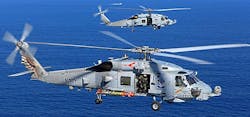Officials of the Naval Surface Warfare Center Crane Division in Crane, Ind., announced a $17.7 million to Raytheon on Friday for 19 Multi-Spectral Targeting (MTS) systems for U.S. Navy MH-60R/S helicopters.
The Raytheon MTS is an airborne, electro-optic, forward-looking infra-red, turreted sensor package that provides long-range surveillance, high altitude target acquisition, tracking, range-finding, and laser designation, and for all tri-service and NATO laser guided munitions.
Raytheon won two contracts earlier this month from the Naval Surface Warfare Center-Crane worth a collective $22.9 million to provide MTS systems for the U.S. Navy Sikorsky MH-60 helicopter and for the U.S. Air Force HC/MC-130J four-engine turboprop aircraft.
The Raytheon MTS is a turreted forward-looking pod combining several visible-light and infrared video cameras for long-range surveillance and high-altitude target acquisition, tracking and laser designation.
Multispectral sensors captures image data at specific frequencies, and separates the wavelengths to extract information the human eye fails to capture with its receptors for red, green and blue. It can detect things like disturbed dirt, and can be effective in finding targets hidden in camouflage.
The Navy's MH-60R Seahawk helicopter are for anti-submarine and anti-surface warfare. The rotorcraft operate from frigates, destroyers, cruisers ,and aircraft carriers. The Navy's MH-60S helicopter is designed for vertical replenishment, combat search and rescue, special warfare support, and airborne mine countermeasures. In its armed configuration it can attack ships and other surface targets.
The Raytheon MTS can be fitted to the C-130 fixed-wing aircraft, the MH-60 helicopter, and the medium-altitude long-endurance MQ-9 Reaper hunter-killer unmanned aerial vehicle (UAV).
Related: Raytheon moves toward full production of upgraded multispectral avionics targeting sensor
The MTS offers a combination of sensors that include multiple-wavelength sensors; near-infrared and color daylight TV cameras; illuminators; eyesafe rangefinders; image merging; spot trackers; and similar other avionics, Raytheon officials say.
The system offers surveillance, target acquisition, tracking, rangefinding, and laser designation for the Hellfire missile and for all tri-service and NATO laser-guided munitions such as the Paveway laser guided bomb.
The advanced targeting forward looking infrared (ATFLIR) pod also is used with used with Paveway, JSOW, and HARM bombs and missiles. The MTS sensors carry the military designations of AAS-52, AAS-53, ASQ-228, DAS-1, and DAS-2.
On the MTS contract announced Friday Raytheon will do the work in McKinney, Texas, and should be finished by March 2016. For more information contact Raytheon Space and Airborne Systems online at www.raytheon.com/capabilities/global_isr, or the Naval Surface Warfare Center, Crane, at www.navsea.navy.mil/nswc/crane.



